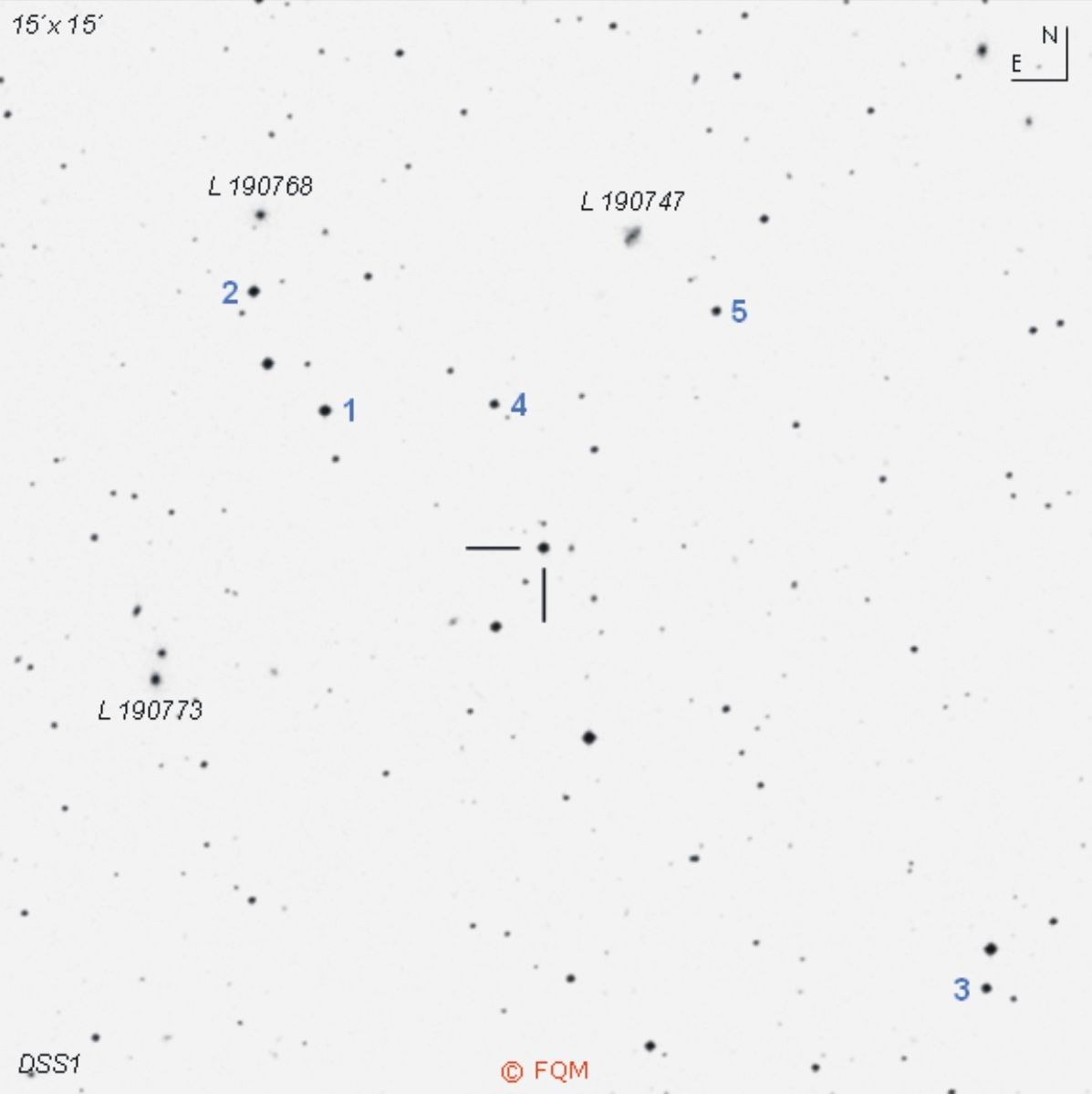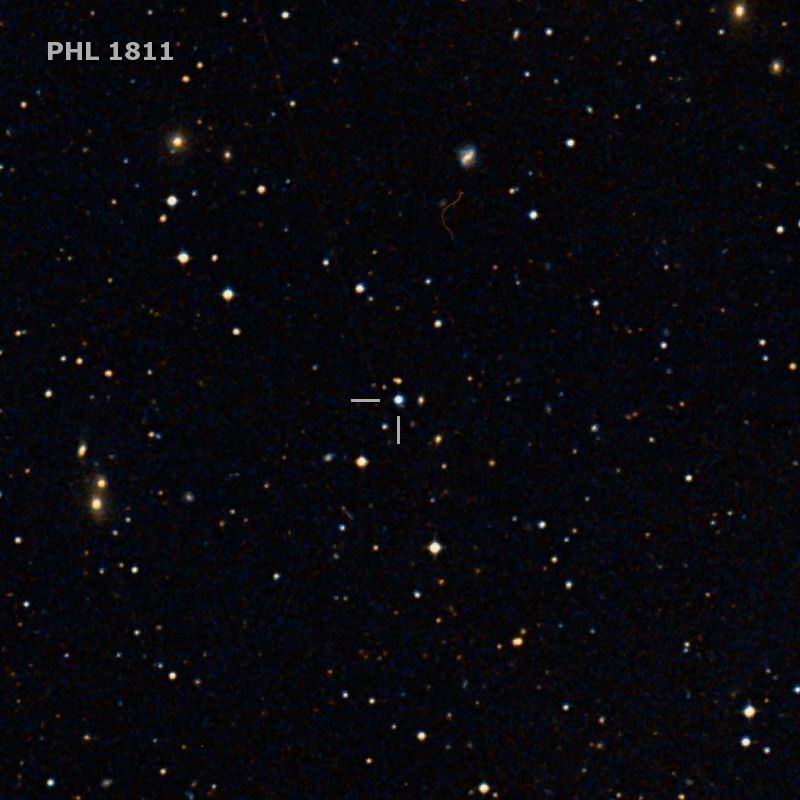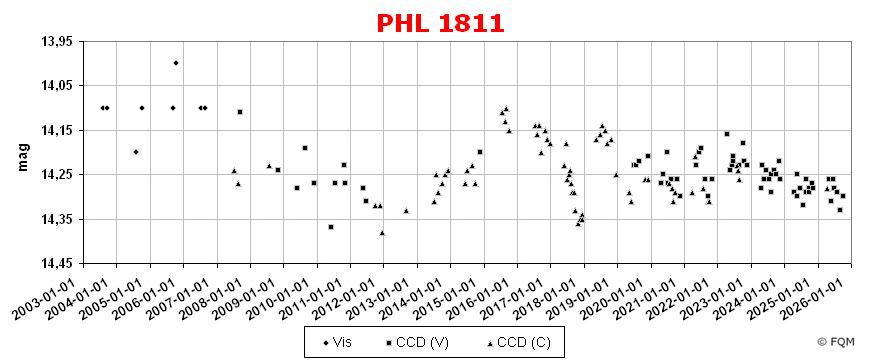
| Frankfurt Quasar Monitoring |
| PHL 1811 |
| Cross-Identifications | QSO J2155-0922, FBQS J2155-0922, QSO B2152-0936 FIRST J215501.4-092224, CXO J215501.5-092224 IRAS F21523-0936, 2XMM J215501.4-092223 |
| Equat. coordinates | RA 21 55 01.4 DE -09 22 24 (J2000) |
| Constellation | Capricornus |
| Type | QSO |
| Redshift | z=0.194 (4) / z=0.190 (2) |
| Distance (2) (3) | 745 Mpc |
| Total mag range (mv) (5) | 14.0 - 15.4 |
| Catalog Magnitude (1) | 13.90 |
| Absolute Magnitude (1) | -26.5 MB |
| Light Travel-Time (2) | 2.228 × 109 yrs |

Comparison stars
| star | B | V |
| 1 | 14.325 (0.000) |
13.692 (0.023) |
| 2 | 14.551 (0.025) |
13.898 (0.024) |
| 3 | 15.308 (0.085) |
14.683 (0.014) |
| 4 | 15.809 (0.000) | 15.055 (0.015) |
| 5 | 15.690 (0.016) | 15.131 (0.014) |


| PHL
1811 is a bright quasar in north-eastern Capricornus, close to the
constellation Aquarius. PHL 1811 was discovered in 1962 as a blue
stellar
object by the Palomar-Haro-Luyten Survey (PHL), searching for blue
stellar objects. The "real" discovery goes back to 1997 during the
FIRST Bright Quasar
Survey (FBQS), a follow up investigation of data received during the
FIRST-Radio Survey, carried out by the Very Large Array (VLA). During
a check-up of the radio position of
PHL 1811 with the POSS 1
photographic plates, a blue stellar object of R=13.87 / B=14.13 was
found as the optical counterpart (see colour chart above). At the time
of discovery, PHL 1811 was the second brightest quasar ever
detected at z > 0.1 (after 3C:273). Follow-up
spectroscopic investigations in 1997 with the Multi Mirror
Telescope (MMT) revealed a Narrow-Line
Seyfert
1-spectrum (NLS1) with a redshift
of z=0.192, which led to the quasar classification. A redshift
of z=0.192 means a distance of a little more than 2×109
light-years. So quasar PHL 1811 can be best described as a radio quiet,
high-luminosity Narrow-Line Seyfert 1. PHL 1811 was first published as
a quasar in the 10th edition of the Catalogue
of Quasars and Active Nuclei (Véron-Cetty & Véron, 2001). Quasar PHL 1811 is a small amplitude variable object with a total range of about 1.5 mag in the optical. The Frankfurt Quasar Monitoring programme has detected the quasar as a bright stellar object ranging between 14.0 mag and 14.4 mag. Visual observers need at least an 8- to 10-inch telescope or larger to glimpse this stellar object. Even for observers with large aperture telescopes this quasar remains a stellar object. CCD observers, as well as visual observers, shall use the comparison stars given above. ____________
PHL
1811 is located in the north-eastern part of Capricornus, very close to
the constellation Aquarius. Some 2° west of quasar PHL 1811, the two
stars 46 Cap and 47
Cap guide the observer to the quasar position. The larger area
(10°-15°) around quasar PHL 1811 offers some
interesting deep sky objects for the dedicated observer. First there
are three globular clusters from the Messier catalog: M2,
M30 and M72. Secondly, two prominent planetary nebulae shall not be
missed: NGC
7293, the Helix-Nebula, and NGC 7009, the Saturn-Nebula.
Stargazers who like to observe another interesting quasar may focus on MRK 509, a very bright 13-mag quasar at a distance of about 400 million light-years, 17° W of PHL 1811. MRK 509 is one of the nearest quasi-stellar objects known. |
| Becker, R.H., White, R.L., et al. 2001, ApJS, 135, 227; The FIRST Bright Quasar Survey. III. The South Galactic Cap. Gaskell, C.S., et al. 2006, ASP Conf. Ser., 390, 1; Optical Variability of the Three Brightest Nearby Quasars. Gregg, M.D., Becker, R.H., White, R.L., et al. 1996, AJ, 112, 407; The First Bright QSO Survey. Leighly, K.M., Halpern, J.P., et al. 2001, AJ, 121, 2889; FIRST Observations of the Second-Brightest Quasar. Karge, S.; Helle Quasare für 8- bis 10-Zoll Teleskope. Ein Beobachtungsführer zur visuellen Beobachtung von Quasaren und BL Lacertae Objekten; Frankfurt 2005. Véron-Cetty, M.-P., Véron, P. 2001, A&A 374, 92; A Catalogue of Quasars and Active Nuclei: 10th edition. Véron-Cetty, M.-P., Véron, P. 2003, A&A 412, 399; A Catalogue of Quasars and Active Nuclei: 11th edition. Véron-Cetty, M.-P., Véron, P. 2006, A&A 455, 776; A Catalogue of Quasars and Active Nuclei: 12th edition. Véron-Cetty, M.-P., Véron, P. 2010, A&A 518, 10; A Catalogue of Quasars and Active Nuclei: 13th edition. |
| Link: |
| home |